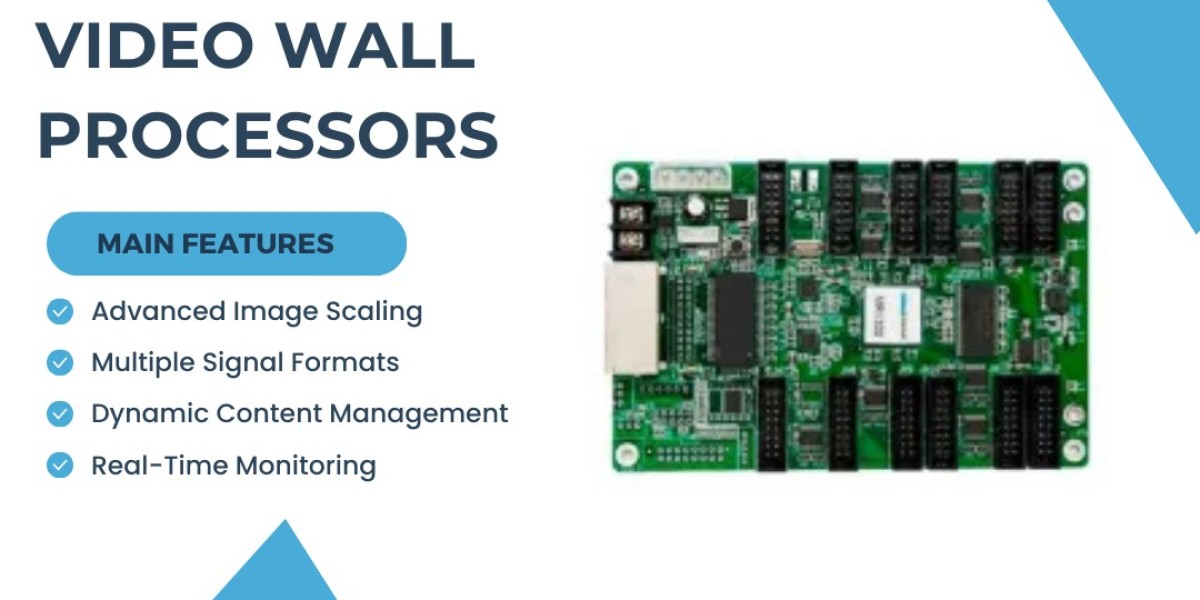If you’ve ever been mesmerized by a giant screen made up of multiple smaller screens working together seamlessly, chances are there’s a video wall processor working behind the scenes. These processors are the unsung heroes of high-impact digital displays—turning multiple display units into one cohesive screen that delivers a unified message or video stream.
In simple terms, a video wall processor takes several input sources (like media players, cameras, or PCs) and distributes the content across multiple screens. It doesn’t just mirror the same image everywhere—it intelligently splits and scales content, allowing for custom layouts and synchronized playback. Whether it’s a security control room in Islamabad or a high-end showroom in Lahore, video wall processors in Pakistan ensure every screen panel plays its part perfectly.
Why Do You Need a Video Wall Processor?
Let’s say you want to run a massive LED video wall for your brand’s product launch. You can’t just plug your laptop into a splitter and expect flawless results. That’s where a video wall processor steps in. It provides:
Content flexibility: Mix multiple media sources, play live feeds, or rotate layouts easily.
Image synchronization: It ensures all displays work together without lag or misalignment.
High-quality resolution scaling: Your content stays crisp whether it's HD or 4K.
Basically, it gives you control, quality, and impact. No more pixelated screens or misaligned content—just smooth, stunning visuals.
Where Are Video Wall Processors Commonly Used in Pakistan?
Video wall processors are everywhere you look—if you know where to look. In Pakistan, they’re being adopted rapidly across various sectors:
Security and surveillance: Think of large-scale control rooms for city traffic monitoring in Karachi or airport security in Islamabad.
Corporate spaces: Boardrooms in Lahore and conference halls in Multan use them for presentations and video conferencing.
Retail and advertising: Malls, showrooms, and brand stores in cities like Faisalabad and Rawalpindi use video walls to dazzle customers.
Broadcasting and events: From live cricket coverage to concerts, video wall processors keep the action big and bold.
Types of Video Wall Processors
Not all video wall processors are created equal. Depending on the use case, you’ll find several types:
1. Hardware-Based Processors
These are robust, standalone units built to handle large inputs and outputs. They’re ideal for mission-critical setups like control centers.
2. Software-Based Processors
Perfect for more flexible environments, these processors run on PCs and offer extensive customization for layout and source management.
3. Hybrid Processors
These combine the best of both worlds—offering reliability with the freedom to update or scale digitally.
Each type has its own strengths, so choosing the right one depends on your goals, scale, and budget.
Key Features to Look for When Buying a Video Wall Processor
Choosing a processor isn’t just about price—it’s about capability. Here’s what you should consider:
Input/Output Flexibility: Can it handle HDMI, VGA, DVI, or DisplayPort? The more options, the better.
Resolution Support: Make sure it supports up to 4K or higher if you’re going for high-end display.
Video Wall Layouts: Custom grid control is essential—2x2, 3x3, or even creative mixed layouts.
User Interface: Go for intuitive control software with real-time preview and drag-and-drop configuration.
Multi-Source Support: You should be able to stream from different sources like a media player, live camera, or PC simultaneously.
Installation Tips for Video Wall Systems in Pakistan
Setting up a video wall isn’t a plug-and-play job, especially with a processor involved. Here's what you need to plan:
Proper cabling and power management: Use high-speed HDMI or fiber optics for large-scale setups.
Professional configuration: It’s wise to work with a certified installer in Pakistan who understands wall calibration and alignment.
Ventilation and space: Processors generate heat—make sure your rack or console allows for proper airflow.
Companies like EZisol have been providing expert video wall installation solutions in Pakistan, ensuring systems run flawlessly whether for commercial or industrial use.
Advantages of Using a Processor Over Simple Splitters
You might be tempted to go cheap and use basic HDMI splitters or extenders—but that’s like using duct tape on a Ferrari. Here’s why processors are the smarter investment:
Custom layout creation: Display one large image or several smaller ones on different screens.
Source switching: Instantly switch between input devices.
Signal integrity: Maintain resolution and synchronization across all screens.
Future-proofing: Easily expand to more screens or inputs as your business grows.
Think of a processor as the brain of your display wall—it’s what makes the difference between amateur setup and professional-grade presentation.
Best Practices for Maintaining Your Video Wall Processor
Just like any tech equipment, processors need a little TLC. Follow these tips:
Keep it dust-free: Dust can clog fans and cause overheating.
Avoid overloading inputs: Always check power and load limits.
Update software: If using a hybrid or software-based processor, keep the firmware or app updated.
Schedule regular inspections: Especially in high-use environments like malls or control rooms.
Proper maintenance extends the life of your system and keeps everything running like a charm.
Conclusion
Whether you’re setting up a retail display, an office presentation room, or a full-scale control center, a video wall processor is what holds everything together. It’s the key to delivering seamless, professional visuals that grab attention and communicate effectively. From choosing the right type to knowing where to install it in Pakistan, every detail matters. Don’t cut corners—invest in the brain of your video wall system and watch your content come to life.
FAQs
1. Can I use a video wall processor for live events?
Absolutely! They're ideal for concerts, sports events, and conferences to display synchronized visuals across large screens.
2. Are video wall processors expensive in Pakistan?
Prices vary by brand and features, but companies like EZisol offer budget-friendly and high-performance options tailored for local markets.
3. What's the difference between a video splitter and a processor?
A splitter shows the same image on all screens. A processor customizes each screen’s output for a unified or segmented display.
4. How many screens can a video wall processor handle?
It depends on the model—some handle 4 screens, others can manage 64 or more in large control rooms.
5. Do I need a professional installer for a video wall processor?
Yes, especially for advanced setups. Professional installers ensure proper calibration, connectivity, and software configuration.


